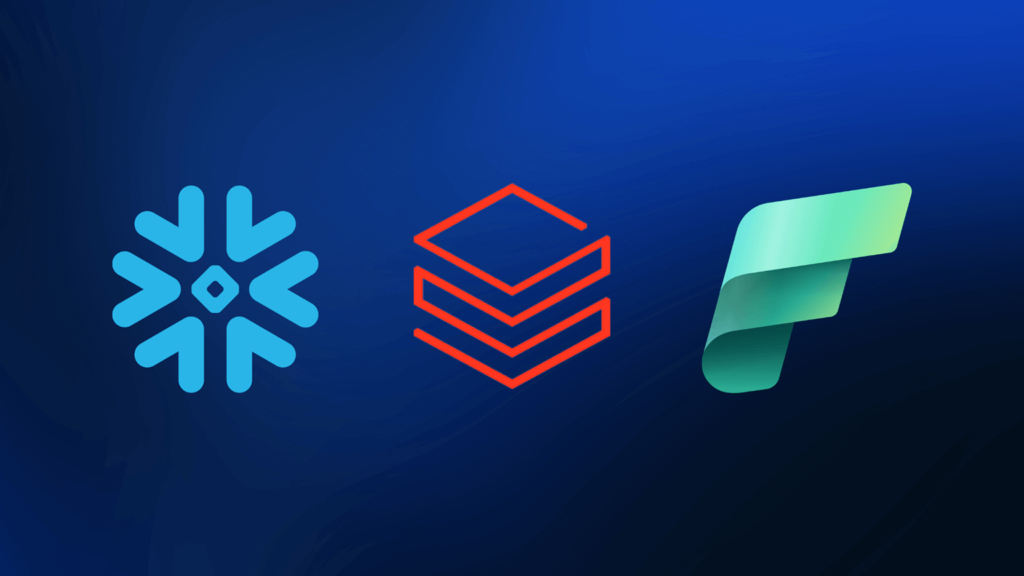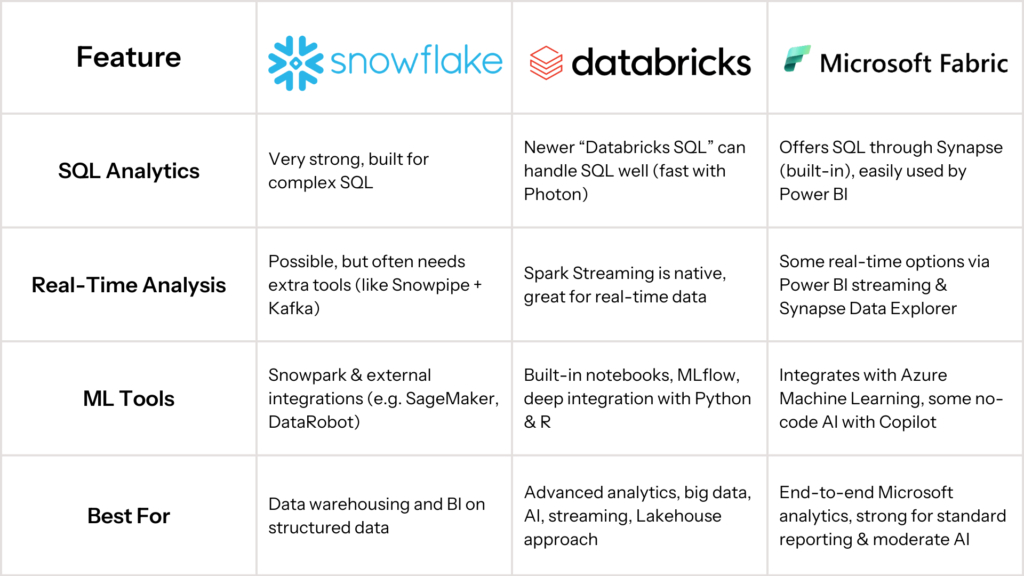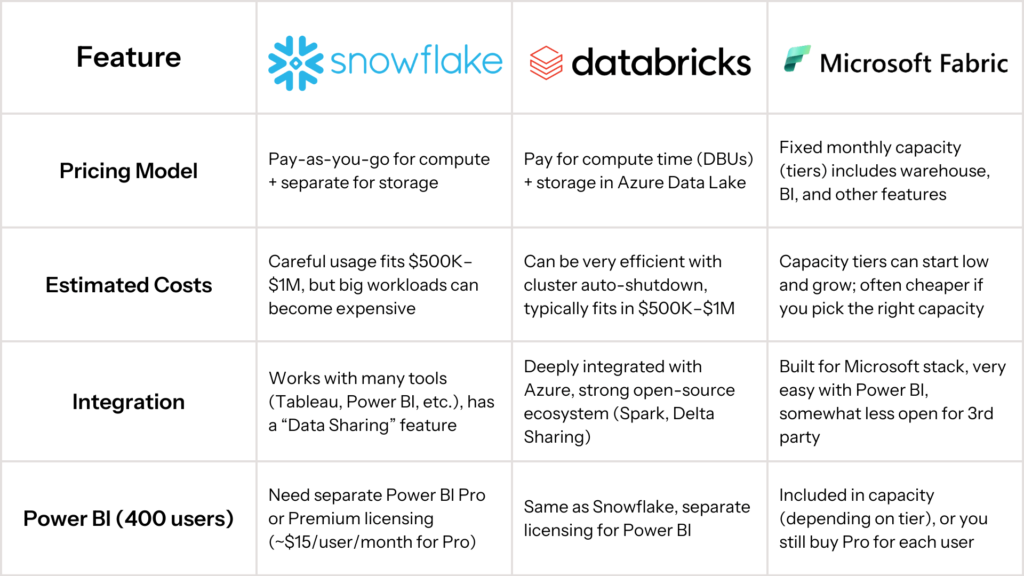In today’s world, every company collects a lot of data. This is especially true in retail, where you want to understand what products are selling, how much inventory you have, and what your customers are doing online. Having the right data platform, a system where you store and analyse all your data, can give you a big advantage.

If you are a leader in your company, you may have heard about Snowflake, Databricks, and Microsoft Fabric. All three are powerful tools that can help your business manage data, run reports, and even do machine learning (ML) or artificial intelligence (AI). But which one is right for you?
Let me explain, in simple terms, the main differences between these three platforms. By the end, you should have a clear idea of which solution might be best for your retail business on Azure, especially if you have a budget of $500K to $1M per year and about 400 people using tools like Power BI.

Why Data Matters in Retail
Before we compare the three platforms, let’s talk about why data is so important in retail. Here are just a few examples:
- Sales Tracking: You want to know which products are selling well and which are not.
- Inventory Management: You need to make sure you have enough items in stock but not too many.
- Customer Behavior: You want to learn how often customers shop, what they buy, and why they stop buying.
- Trends and Predictions: You can use AI and ML to predict what people will buy next, or when it makes sense to increase or lower your priceses.
A good data platform will help you store all your data in one place and then run reports or advanced algorithms to gain insights. Now, let’s meet the three platforms we’re talking about.
Introducing the Big Three
1. Snowflake
Snowflake is a cloud data warehouse. It stores all your data (sales records, inventory data, etc.) and lets you run powerful SQL queries on it. “SQL” is a language that helps you ask questions about your data and get results. Snowflake is known for being very good at quickly returning answers to even the toughest queries.
Key Points:
- Data Storage: Stores all your data in Snowflake’s system, separate from the computers that do the work.
- Compute: You pay for how much you use (credits). If you do a lot of queries, you might spend more.
- Ease of Use: Many people find Snowflake simple to set up and learn.
- AI/ML: Snowflake itself doesn’t have a deep AI/ML environment. You often connect it to other tools for that.
2. Databricks
Databricks is a Lakehouse platform built on Apache Spark. A “Lakehouse” is a fancy word for a system that can handle both structured data (like sales tables) and unstructured data (like product images) in one place. Databricks is great for big data and machine learning because it has a lot of tools that help data scientists train models on huge amounts of data.
Key Points:
- Data Storage: Usually sits on top of your own Azure Data Lake, keeping data in open formats like Delta Lake.
- Compute: Uses “clusters” of servers; you pay for how long they run. You can shut them off to save money.
- Ease of Use: Technical people (data engineers, data scientists) love it. Non-technical folks might need a separate reporting tool, like Power BI.
- AI/ML: Excellent environment for advanced analytics, real-time data, and big ML projects.
3. Microsoft Fabric
Microsoft Fabric is a new platform that combines many tools from Microsoft, like Power BI, Azure Synapse, and Data Factory, under one umbrella. You can store data in “OneLake,” analyse it with Power BI, or set up pipelines, all without leaving Fabric’s interface. If you’re already using PowerBI, then you’re already familiar with the interface, it’s the same one.
Key Points:
- Data Storage: Uses “OneLake,” a single place to keep your data (both structured and unstructured).
- Compute: You buy a certain “capacity” (like small, medium, or large). It’s a fixed monthly cost for that block of resources.
- Ease of Use: If your business already uses lots of Microsoft products, Fabric feels very familiar.
- AI/ML: Integrates with Azure Machine Learning, has some built-in Spark clusters, and even “Copilot” features for easy AI.
Comparison Tables
The following tables highlight the differences in a more straightforward, side-by-side way.
Table 1: Data Storage & Processing

Table 2: Analytics & AI/ML

Table 3: Cost & Integration

Explanation in Simple Words
Snowflake is like a giant library for your data, but you pay more if you read a lot of books or read them very often. It’s best at quickly answering questions (SQL queries) about structured information, like transactions or customer data. But if you want to do fancy AI or streaming data (where things come in every second), Snowflake alone isn’t enough, you’ll need other tools.
Databricks is like a big science lab. You can do experiments on very large sets of data. It supports both neat, structured data (like your store’s sales records) and messy, unstructured data (like text or images). Databricks runs on Spark, a powerful engine that can handle big tasks fast. If you want to build AI models that predict, for example, how many sneakers you’ll sell next month, Databricks is great. But if you only want simple dashboards, it might feel like overkill, though you can still do it easily with Power BI.
Microsoft Fabric is like a new super tool that tries to handle everything in one place. It gives you a data lake, a data warehouse, reporting (Power BI), and other things all in a single package. You don’t have to deal with separate pieces if you prefer a one-stop shop, especially if you already love Microsoft tools like Azure and Power BI. But, because it’s new, some advanced features (like huge-scale real-time analytics) might not be as proven as Databricks for extremely large or complex data. Also, third-party tools can connect, but it’s very Microsoft-centric.

Fitting the Budget: $500K–$1M Per Year
For a retail business, you might have a yearly budget between $500,000 and $1 million. This budget includes your data platform plus Power BI for your 400 team members.
- Snowflake:
- Pros: Easy for SQL analysts, strong data sharing, quick setup.
- Cons: If you run many queries, costs can spike. AI/ML often requires another tool.
- Potential Fit: Good if you mostly want a fast data warehouse and can watch your credits closely.
- Databricks:
- Pros: Very flexible for big data and ML, you only pay for compute while it’s running.
- Cons: More technical to set up. Need governance so people don’t leave big clusters running.
- Potential Fit: Great if you plan to run advanced analytics or real-time data pipelines and want maximum control.
- Microsoft Fabric:
- Pros: Simple “capacity” pricing, one place for data pipelines, warehouse, and Power BI, as well as tight Microsoft integration.
- Cons: You might overpay if your usage is small or if you need the next big capacity tier. Some parts are new and might not handle the biggest data tasks as smoothly.
- Potential Fit: Fantastic if you are all-in on Microsoft products and want an easy, integrated solution with a predictable monthly cost.
Which One Should You Choose?
It depends on your top priorities:
- Speedy SQL and Data Sharing:
Go with Snowflake if your main goal is to have a powerful data warehouse for standard reports, especially if you work with many external partners who also use Snowflake. - Advanced AI/ML and Big Data:
Pick Databricks if you need to run advanced machine learning models or analyse streaming data. It’s also great to keep your data in open formats so you aren’t locked into one system. - All-in-One Microsoft Experience:
Choose Microsoft Fabric if you are deeply committed to the Microsoft stack and want a single environment that covers data storage, data engineering, and Power BI dashboards, all behind one “pane of glass.”

Final Thoughts
In the retail industry, data has become a superpower. The better you can collect, manage, and analyse your data, the better decisions you can make about inventory, marketing, and customer experience. Whether you pick Snowflake, Databricks, or Microsoft Fabric, you’ll get a modern data platform that helps your business.
Databricks often stands out for retailers because of its ability to handle huge amounts of data and do advanced AI. For example, you might want to predict exactly how many items to stock in each store based on past sales, weather patterns, and even social media trends. Databricks can help you do that end-to-end.
If your business is simpler or more focused on daily reports and dashboards, you might find Snowflake is easier to manage, especially if you want to share data with outside partners.
If you are a huge Microsoft fan or want to keep everything in one place, Fabric is a great choice, just remember that it’s still evolving and might not have every high-end feature you need out of the box.
Keep an eye on your usage and set up controls so you don’t exceed your planned budget. All three tools can scale up as your retail business grows.
Think of them like different modes of transportation: whether you need a quick car, a robust truck, or a fully equipped bus depends on your journey!

